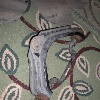tjrtmaster
Member
- Joined
- May 25, 2009
- Messages
- 25
- Reaction score
- 0
- City, State
- Greensboro, NC
- Year, Model & Trim Level
- 96
The AC on my Explorer had been running great all summer. I checked it a few weeks ago with a gauge that is used to add more refrigerant and it was well into the green. Yesterday I got no cool air at all even when on Max AC. The compressor cycles on and off constantly every few seconds. To find the problem should I add dye and look for leaks or get a loaner gauge set from Auto-Zone and check the high and low pressures?
Any troubleshooting techniques would be appreciated.
What psi should the high and low read?
Any troubleshooting techniques would be appreciated.
What psi should the high and low read?










